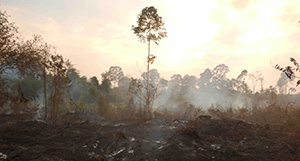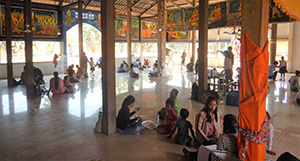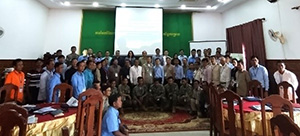Home > International Partnerships > Collaborative Research > Does Forest Conservation Contribute to the Improvement of the Nutritional Status of Rural Residents in Developing Countries?
Update:October 18, 2024
Main content starts here.
Does Forest Conservation Contribute to the Improvement of the Nutritional Status of Rural Residents in Developing Countries?

Left: Forest in Cambodia, Center: Group photo taken during field survey, Right: Food in a rural village (©Saiko Shikanai)
1. Partners
General Directorate of National Protected Area, Ministry of Environment, Kingdom of Cambodia
Conservation International
Asian Nutrition and Food Research Center *NGO in Cambodia
National Institute for Environmental Studies, Japan
Aomori University of Health and Welfare, Japan
2. Research Period
FY 2019-2026 (until 2023, funded by Grants-in-Aid for Scientific Research (KAKENHI))
3. Lead Researcher
EHARA, Makoto (Center for Biodiversity and Climate Change)
4. Background
Forests in developing countries provide local residents with various foods, including wild vegetables, mushrooms, and wild meat. These foods are often gathered on a daily basis and tend to have high nutritional values, which can contribute to maintaining the health of the local population. However, the effectiveness of the forest food supply is declining in many places because the forests are being depleted due to conversion to other land uses. Developing countries generally establish protected forest areas and support the livelihood of nearby residents as forest conservation measures. Earlier studies examined the effects of these interventions only in terms of changes in forest area, reduction of greenhouse gas emissions from deforestation and forest degradation (REDD+), biodiversity conservation, and socioeconomic impacts on the surrounding area. There is limited understanding regarding whether forest conservation improves local food provisioning and, thus, the nutritional status of forest-dependent communities.
5. Research Goal
The overall objective is to determine whether forest conservation under a REDD+ project under the JCM (Joint Crediting Mechanism) positively affects the residents’ dietary and nutritional diversity and improves the nutritional status of the children. The REDD+ project is implemented around the Prey Lang Wildlife Sanctuary (PLWS) in Stung Treng province of Cambodia, and is undertaken jointly by the Cambodian Ministry of Environment, the Provincial Department of Environment, and Conservation International.
6. Research Strategy
This study explores the relationship between forests and food not only through the surrogate indicators of food type used in traditional research but also through individual household-based follow-up of indicators of children's nutrient intake (macronutrients and micronutrients) and nutritional status (height and weight). By applying a quasi-experimental design, we attempt to assess the net effect of forest conservation on maintaining the diversity of nutrient intake of the population and improving the nutritional status of children.
7. Expected Outcomes
Two surveys were conducted with sample households living in and around PLWS, one in February 2020 (first) and the other in February 2024 (second). The second survey allowed us to collect both nutritional and socioeconomic data from approximately 86% (140 households) of the 161 households studied in the first survey.
Through data obtained from the first survey (means of livelihood, diet, and height and weight of the children), the nutritional status of 161 children was assessed. The percentage of children with stunted growth (children with a HAZ of -2 or less) was 26.1%. We found that children who obtained food through purchase rather than subsistence farming tended to have higher intakes of energy and many nutrients (macronutrients, minerals, and vitamins). We also found that some wild species contributed to higher intakes of calcium and potassium.
Thus, the results suggest that forest conservation measures that take into consideration the improvement of local children's nutrition should not only protect the forests but also secure a source of cash income necessary for the residents to purchase food. The natural resin obtained from Dipterocarpaceae trees, a traditional local source of cash income, is a promising means of achieving both forest conservation and income at the same time. However, some households that have experienced a sharp decline in income from resin as a result of illegal logging have turned to illegal logging themselves in order to maintain their livelihoods. To protect the natural resin collection industry and the livelihoods associated with it, we have developed a series of methods to predict the distribution of priority areas for combating illegal logging in the PLWS's southwestern region (For more information, please see Ehara et al. (2023)).
Based on our tentative results, a possible proposal for a nutrition-sensitive forest conservation policy is to protect cash income sources such as household resin extraction as part of conservation activities to facilitate the purchase of nutritious food, and to combine this with nutrition education. Our findings were shared at a workshop attended by local residents, provincial governors, administrative authorities, NGOs, and research institutions.
We plan to conduct a detailed analysis of whether the REDD+ project positively affects the diversity of nutrient intake and improves the nutritional status of children, including an analysis of the second survey data. We hope to gain important knowledge for contributing Goal 15 (life on land) as well as Goal 1 (no poverty), Goal 2(zero hunger), Goal 3 (good health and well-being) and Goal 13 (climate action) of the UN Sustainable Development Goals (SDGs).

Deforestation in the field

Questionnaire survey with the residents

The local workshop where the results were presented
Technical terms
Joint Crediting Mechanism (JCM): The JCM aims to facilitate the diffusion of leading decarbonizing technologies, infrastructure, etc., through investment by Japanese entities, thereby contributing to GHG emission reductions or removals and sustainable development in partner countries. The JCM contributes to the achievement of both countries’ emissions reduction targets by evaluating Japan’s contributions in a quantitative manner and acquiring part of the credit. (https://www.mofa.go.jp/ic/ch/page1we_000105.html( External link ))
Prey Lang Wildlife Sanctuary: a 431,683 ha wildlife sanctuary established in 2016. A REDD+ project is also underway in and around the sanctuary to mitigate global climate change by reducing greenhouse gas emissions due to deforestation and forest degradation. The collection of non-timber forest products for the livelihood of local people in the protected area is legal, provided that prior consent is obtained from the administrative authorities and the impact of the collection on biodiversity is taken into account.
Dipterocarpaceae: a representative taxon of trees in the tropical forests of Southeast Asia. Timber is produced by logging from natural forests, and resin is extracted from the trunks.
8. Publications
Ehara M, Matsuura T, Gong Hao, Sokh H, Leng C, Choeung HN, Sem R, Nomura H, Tsuyama I, Matsui T, Hyakumura K (2023) Where do people vulnerable to deforestation live? Triaging forest conservation interventions for sustainable non-timber forest products. https://doi.org/10.1016/j.landusepol.2023.106637( External link )
(Conference presentations, etc.)
Furukawa T, Shikanai S, Sekiyama M, Ehara M, Voeun S, Ly K, Hon N, Frechette J, Net N (2022) Nutrient deficiency in children in the deforested front of IUNS-ICN, 22:SY(T8)1-4.
Sekiyama M, Shikanai S, Furukawa T, Ehara M, Voeun S, Ly K, Hon N, Frechette J, Sreyoun I, Net N (2022) Child nutritional intake in rural Cambodia: Application of Food Frequency Questionnaire and comparison with 24-h recall data. IUNS-ICN, 22:PAB(T6)-223.
Furukawa T, Shikanai S, Sekiyama M, Ehara M, Vouen S, Ly K, Hon N, Frechette J, Uraguchi A, Sreyoun I, Net N (2022) Food sources and child nutrition in the S Sekiyama M, Ehara M, Vouen S, Ly K, Hon N, Frechette J, Uraguchi A, Sreyoun I, Net N (2022) Food sources and child nutrition in the deforestation front of Cambodia. Proceedings of the Ecological Society of Japan, 69:P2-330
Ehara M, Furukawa T, Sekiyama M, Shikanai S, Voeun S, Ly K, Hon N, Frechette J, Net N (2024) Interim Update on KAKEN project: Does forest conservation Interim Update on KAKEN project: Does forest conservation contribute to the improvement of the nutritional status of rural residents in Stung Treng, Cambodia? Stakeholder workshop: The Role of Agriculture and Forest Landscapes on Human and Environmental Health. pp.7-8.
(MISC)
Kohsaka R, Uchiyama Y, Ehara M (2020) Trend of science policy interface and nature’s contribution to people and ecosystem services in IPBES. Society and Ethics Journal (Shakai to Rinri), 35(35) 21-37
(Books)
Ehara M, Saito H, Matsuura T (2021) Non-Timber Forest Products. In: Shinringaku no Hyakkajiten. The Japanese Forest Society. pp.360-361. Maruzen Publishing Co., Ltd.
Furukawa T (2021) State of the World's Forests. In: Shinringaku no Hyakkajiten. The Japanese Forest Society. pp.58-59. Maruzen Publishing Co., Ltd.
Furukawa T (2021) Fuelwood Use. In: Shinringaku no Hyakkajiten. The Japanese Forest Society. pp.372-373. Maruzen Publishing Co., Ltd.
Sekiyama M (2023) International organizations and academic groups related to nutrition education. In: Encyclopedia of Nutrition Education. Japan Society for Nutrition Education. pp.344-347. Maruzen Publishing Co., Ltd.
Sekiyama M (2023) Current status of international food aid activities. In: Encyclopedia of Nutrition Education. Japan Society for Nutrition Education. pp.348-349. Maruzen Publishing Co., Ltd.
Shikanai S, Sekiyama M (2023) Nutrition education case studies in developing countries. In: Encyclopedia of Nutrition Education. Japan Society for Nutrition Education. pp.352-353. Maruzen Publishing Co., Ltd.
Shikanai S (2024) Case Study 2: Forest Conservation and Nutritional Intake Status of Local People, and Potential for Nutritional Improvement: Case of Cambodia. In: International Nutrition -Global Nutrition Challenges and its Countermeasures-. pp.187-189. Kenpakusha.
Copyright © Forest Research and Management Organization. All rights reserved.
